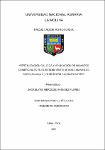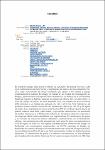Mostrar el registro sencillo del ítem
Fertilización cálcica y aplicación de humatos comerciales en el rendimiento de maíz amarillo duro (Zea mays L.) híbrido PM-213; bajo goteo
| dc.contributor.advisor | Hurtado Leo, Lorenzo Miguel | |
| dc.contributor.author | Méndez Flores, Jackelyne Mercedes | |
| dc.date.accessioned | 2018-12-05T14:54:15Z | |
| dc.date.available | 2018-12-05T14:54:15Z | |
| dc.date.issued | 2018 | |
| dc.identifier.other | F04.M4553-T BAN UNALM | |
| dc.identifier.uri | https://hdl.handle.net/20.500.12996/3719 | |
| dc.description | Universidad Nacional Agraria La Molina. Facultad de Agronomía. Departamento Académico de Suelos | es_PE |
| dc.description.abstract | El presente trabajo trata sobre el efecto de aplicación de ácidos húmicos y del nivel nutricional en el crecimiento y rendimiento del cultivo de maíz amarrillo PM-213, bajo condiciones de riego localizado por goteo y en suelos y aguas moderadamente salinas. El ensayo se realizó en la Unidad de Investigación en Riegos, perteneciente al Departamento Académico de Suelos de la Universidad Nacional Agraria la Molina, durante los meses de Enero 2013 a Julio 2013. A nivel de campo se probó, en maíz amarrillo duro, dos niveles de ácido húmicos (AH) en base a un testigo no aplicado (0, 120 y 240 l/ha AH). Asimismo, se probaron cuatro niveles crecientes de fertilización cálcica (0, 30, 60 y 90 kg/ha de CaO). Las respuestas en maíz amarillo duro PM 213 indican que la altura de planta, materia seca total y área foliar, no presentan diferencias a la aplicación de ácidos húmicos y a la fertilización cálcica. En la materia seca de mazorcas y de hojas las diferencias estadisticas son significativas. El rendimiento de grano y el número de mazorcas fueron afectados positivamente por la fertilización cálcica. Los rendimientos más elevados de maíz amarillo duro, se presentaron a nivel 60 kg/ha de CaO (11,149 kg/ha) estadísticamente diferente del testigo no fertilizado con incrementos porcentuales de 27.7% respecto al testigo no fertilizado con calcio y el mayor número de mazorcas a nivel de 30 kg/ha de CaO, sin ser diferente de 60 y 90 kg/ha de CaO, en todos los niveles de ácidos húmicos aplicados. El rendimiento de grano y el número de mazorcas, no fue afectado por la aplicación de ácidos húmicos. El consumo de agua durante los 158 días de ciclo vegetativo del cultivo de maíz amarillo duro fue de 5,685 m3/ha, con un rendimiento comercial promedio de 10,066 kg/ha de maíz grano, determinando una Eficiencia de Uso de Agua (EUA) de 1.77 kg de maíz grano producidos por m3 de agua aplicados. Asimismo, los parámetros agronómicos que caracterizan al cultivo de maíz amarillo indican un Índice de área Foliar (IAF) de 6.92 m2/m2 de, un Coeficiente de Transpiración (CT) de 195.9 l/kg, un Indicé de Cosecha (IC) de 40.8 % y una Evapotranspiración del Cultivo (ETc) de 512.1 mm/campaña. El análisis agroeconómico indica que los mayores índices de rentabilidad (IR%) se presentan con la fertilización cálcica y sin la aplicación de ácidos húmicos, con IR% entre 54 y 62 %. Conforme se eleva la dosis de aplicación de ácidos húmicos la rentabilidad disminuye. El menor índice caracteriza al testigo no fertilizado con calcio con 9.3% de rentabilidad. El mayor índice de rentabilidad para ácidos húmicos se presenta a nivel del testigo no aplicado con AH siendo el IR de 51.7%. Asimismo, el menor índice caracteriza al nivel de 240 litros/ha de AH con un IR de -0.2%. | es_PE |
| dc.description.abstract | The present work deals with the effect of application of humic acids and nutritional level on growth and yield of maize yellow PM-213, under conditions of localized irrigation and drip in soil and water moderately salinas. The trial was conducted in the Research Unit in irrigation, belonging to the Academic Department of Soils of the National Agrarian University La Molina, during the months of January 2013 to July 2013. At the field level was tested, in corn yellow hard, two levels of acid humic acids (AH) on the basis of a witness not applied (0, 120 and 240 l/ha AH). Also, were tested four increasing levels of fertilization calcium (0, 30, 60 and 90 kg/ha of CaO. The answers in hard yellow corn PM 213 indicate that the plant height, total dry matter and leaf area, do not present differences in the application of humic acids and to fertilization Calcium, In the dry matter of ears and leaves the statistical differences are significant. The grain yield and the number of ears were positively affected by the fertilization calcium. The highest yields of hard yellow corn were presented to level 60 kg/ha of CaO (11,149 kg/ha) statistically different from the witness not fertilized with percentage increases of 27.7% with respect to the warning light does not fertilized with calcium and the largest number of ears at the level of 30 kg/ha of Ca. The water consumption during 158 days of vegetative cycle of the cultivation of hard yellow corn was 5,685 m3/ha, with 10,066 kg average commercial yield / there is of corn grain, determining an Efficiency of water Use (EUA) of 1.77 kg of corn grain produced for m3 of water applied. Also, the agronomic parameters that they characterize to the cultivation of yellow corn indicate an area Index to Foliate (IAF) of 6.92 m2/m2 of, a Coefficient of Transpiration (CT) of 195.9 l/kg, an Indicé of Harvest (IC) of 40.8 % and an Evapotranspiration of the Cultivation (Etc) 512.1 mm/campaign. The analysis agroeconómico indicates that the highest rates of profitability (GO%) presented with fertilization calcium and without the application of humic acids, with IR% between 54 and 62 %. As it raises the rate of application of humic acids profitability declines. The lowest index characterizes the warning light does not fertilized with calcium with 9.3% of profitability. The highest rate of profitability for humic acids is at the level of the witness not applied with ah being the GO of 51.7%. Also, the lower index characterizes the level of 240 liters/ha ah with an IR -0.2%. | en_US |
| dc.format | application/pdf | en_US |
| dc.language.iso | spa | es_PE |
| dc.publisher | Universidad Nacional Agraria La Molina | es_PE |
| dc.rights | info:eu-repo/semantics/openAccess | en_US |
| dc.rights.uri | https://creativecommons.org/licenses/by-nc-nd/4.0/ | * |
| dc.subject | Zea mays | es_PE |
| dc.subject | Híbridos | es_PE |
| dc.subject | Abonos cálcicos | es_PE |
| dc.subject | Acido húmico | es_PE |
| dc.subject | Rendimiento de cultivos | es_PE |
| dc.subject | Aplicación de abonos | es_PE |
| dc.subject | Características agronómicas | es_PE |
| dc.subject | Riego por goteo | es_PE |
| dc.subject | Tratamiento precosecha | es_PE |
| dc.subject | Manejo del cultivo | es_PE |
| dc.subject | Perú | es_PE |
| dc.subject | Maíz híbrido PM 213 | es_PE |
| dc.subject | Fertilización cálcica | es_PE |
| dc.subject | Humatos | es_PE |
| dc.subject | Maíz amarillo duro | es_PE |
| dc.title | Fertilización cálcica y aplicación de humatos comerciales en el rendimiento de maíz amarillo duro (Zea mays L.) híbrido PM-213; bajo goteo | es_PE |
| dc.type | info:eu-repo/semantics/bachelorThesis | en_US |
| thesis.degree.discipline | Agronomía | es_PE |
| thesis.degree.grantor | Universidad Nacional Agraria La Molina. Facultad de Agronomía | es_PE |
| thesis.degree.name | Ingeniero Agrónomo | es_PE |
| dc.subject.ocde | http://purl.org/pe-repo/ocde/ford#4.01.06 | es_PE |
| renati.author.dni | 44055559 | es_PE |
| dc.publisher.country | PE | es_PE |
| dc.type.version | info:eu-repo/semantics/publishedVersion | en_US |
| renati.advisor.orcid | https://orcid.org/0000-0002-5202-3971 | es_PE |
| renati.advisor.dni | 07922950 | es_PE |
| renati.type | https://purl.org/pe-repo/renati/type#tesis | es_PE |
| renati.level | https://purl.org/pe-repo/renati/level#tituloProfesional | es_PE |
| renati.discipline | 811036 | es_PE |
| renati.juror | Chura Chuquija, Julián | |
| renati.juror | Aguirre Yato, Víctor Guillermo | |
| renati.juror | Palomo Herrera, Ángel Alfonso |
Ficheros en el ítem
Este ítem aparece en la(s) siguiente(s) colección(ones)
-
AGR-SU Tesis [120]




